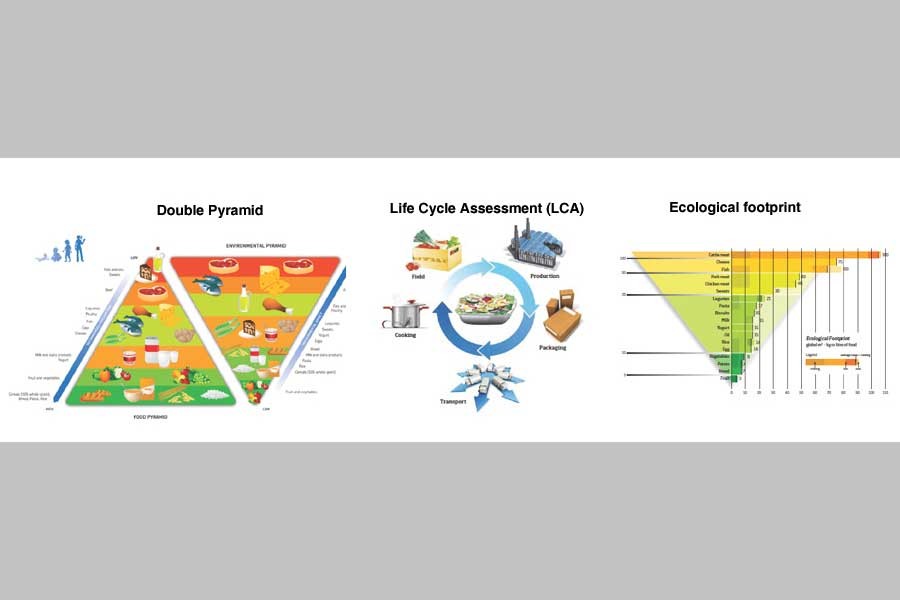In order to maintain nutrition of the body, we need to consume the right food in adequate proportion. Nutritious foods keep our body healthy and active. Everyone should take the required amount of food from all the food groups based on his/her age, sex and physical activities.
Different foods have different effects not only on our body, but also on our environment. To show the effect of different foods on the environment, Barilla Center for Food and Nutrition introduced Double Pyramid in 2010. Many people have some idea about the food pyramid. The Double Pyramid is the combination of the food pyramid and environmental pyramid.
If we look at Double Pyramid (food pyramid and environmental pyramid side by side), we can see the effects that different foods have on the environment.
In the environmental pyramid, we can see foods with adverse impact on the environment are placed on the upper side like meat and cheese; and foods that have less impact on the environment are placed in the lower side like fruits and vegetables. Some exception of this is that olive oil is good for health, but it has adverse impact on the environment.
The impact on the environment is based on greenhouse gas emission (carbon footprint), use of water resources (water footprint) and the use of natural assets (ecological footprint). Impact is considered at every stage of production through Life Cycle Assessment (LCA) method.
It has been found that many foods which are harmful for our bodies are also harmful for the environment. Some foods are very healthy for our bodies and also very environment-friendly. For example, if we eat more fruits and vegetables, we will be healthy and it will have less effect on the environment. On the other side, if we eat even a low amount of red meat and sweets, it will have more impact on the environment.
If we look at the impacts of foods on the environment, we can see that the cereal grain crops have lower water and carbon footprint. Among these crops, greenhouse gas emissions from legume like chickpea and lentil are less than half compared to other crops. The reason is that these crops can fix nitrogen naturally and that's why, nitrogen fertilizer is not required. So the emission of greenhouse gas reduces.
If we compare animal products, the emission of greenhouse gas from vegetables is lower. According to the Journal of Cleaner Production, I kilogram greenhouse gas is emitted from 5.8 kg onion, whereas, the same amount of gas is emitted by 44 grams of beef. A similar situation is applicable about ecological footprint.
WATER FOOTPRINT: Water footprint measures the amount of water used at individual, community and national levels. Increase of water footprint can create water scarcity and problems like
- Lack of access to drinking water
- Hampered crop production
- Death of animals
- Hunger
- Hampered education-- sometimes children get too sick to go to school or they work to get water for the family
- Occurrence of diseases
- Sanitation problems
- Mental health problems like depression and anxiety
- Reduced productivity, as people get sick because of the scarcity of water
- Reduced income
ECOLOGICAL FOOTPRINT: Ecological Footprint measures human impact on the earth's eco systems. The biologically productive area provide people with different things like foods --fruits, vegetables, fish; shelter-- buildings; furniture and fuel-- wood. If ecological footprint increases, problems occur like
- Forests shrinking
- Biodiversity loss
- Freshwater stress
- Climate change
- Increase of social and economic costs. As our resources are limited, excessive consumption by some people have negative impact elsewhere on other people.
CARBON FOOTPRINT: Carbon Footprint measures the resources we consume, both directly and indirectly. Directly, it can be the kind of car we drive and how hot or cold we keep our houses or workplaces. Indirectly, it will depend on how much energy is required to produce the products we buy. When carbon-based energy is used, harmful gases are emitted which
- Adversely affect the planet's atmospheric balance and
- Greatly strike the climate
So, we need to consider the above mentioned issues seriously. If we follow the Double Pyramid, then not only we will keep ourselves healthy, but our environment will also be protected for us as well as for the next generation.


